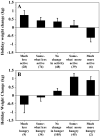A prospective study of holiday weight gain
- PMID: 10727591
- PMCID: PMC4336296
- DOI: 10.1056/NEJM200003233421206
A prospective study of holiday weight gain
Abstract
Background: It is commonly asserted that the average American gains 5 lb (2.3 kg) or more over the holiday period between Thanksgiving and New Year's Day, yet few data support this statement.
Methods: To estimate actual holiday-related weight variation, we measured body weight in a convenience sample of 195 adults. The subjects were weighed four times at intervals of six to eight weeks, so that weight change was determined for three periods: preholiday (from late September or early October to mid-November), holiday (from mid-November to early or mid-January), and postholiday (from early or mid-January to late February or early March). A final measurement of body weight was obtained in 165 subjects the following September or October. Data on other vital signs and self-reported health measures were obtained from the patients in order to mask the main outcome of interest.
Results: The mean (+/-SD) weight increased significantly during the holiday period (gain, 0.37+/-1.52 kg; P<0.001), but not during the preholiday period (gain, 0.18+/-1.49 kg; P=0.09) or the postholiday period (loss, 0.07+/-1.14 kg; P=0.36). As compared with their weight in late September or early October, the study subjects had an average net weight gain of 0.48+/-2.22 kg in late February or March (P=0.003). Between February or March and the next September or early October, there was no significant additional change in weight (gain, 0.21 kg+/-2.3 kg; P=0.13) for the 165 participants who returned for follow-up.
Conclusions: The average holiday weight gain is less than commonly asserted. Since this gain is not reversed during the spring or summer months, the net 0.48-kg weight gain in the fall and winter probably contributes to the increase in body weight that frequently occurs during adulthood.
Figures




References
-
- Kuczmarski RJ, Carroll MD, Flegal KM, Troiano RP. Varying body mass index cutoff points to describe overweight prevalence among U.S. adults: NHANES III (1988 to 1994) Obes Res. 1997;5:542–548. - PubMed
-
- Flegal KM, Carroll MD, Kuczmarski RJ, Johnson CL. Overweight and obesity in the United States: prevalence and trends, 1960-1994. Int J Obes Relat Metab Disord. 1998;22:39–47. - PubMed
-
- Anon. Clinical Guidelines on the Identification, Evaluation, and Treatment of Overweight and Obesity in Adults--The Evidence Report. National Institutes of Health. Obes Res. 1998;6(Suppl 2):51S–209S. - PubMed
-
- Najjar MF, Rowland M. Anthropometric reference data and prevalence of overweight, United States, 1976-80. Vital Health Stat. 1987;11:1–73. - PubMed
-
- Serdula MK, Ivery D, Coates RJ, Freedman DS, Williamson DF, Byers T. Do obese children become obese adults? A review of the literature Prev Med. 1993;22:167–77. - PubMed
Publication types
MeSH terms
Grants and funding
LinkOut - more resources
Full Text Sources
Medical
Research Materials
